+ Open data
Open data
- Basic information
Basic information
| Entry | Database: PDB / ID: 7b38 | ||||||
|---|---|---|---|---|---|---|---|
| Title | Torpedo californica acetylcholinesterase complexed with Mg+2 | ||||||
 Components Components | Acetylcholinesterase | ||||||
 Keywords Keywords | HYDROLASE / acetylcholinesterase / ASSAM / differential scanning calorimetry / divalent metal ion / electron paramagnetic resonance / thermal inactivation / Torpedo / 4D motif / 3.1.1.7 | ||||||
| Function / homology |  Function and homology information Function and homology informationacetylcholine catabolic process in synaptic cleft / choline metabolic process / acetylcholinesterase / acetylcholinesterase activity / synaptic cleft / side of membrane / synapse / extracellular space / plasma membrane Similarity search - Function | ||||||
| Biological species |  | ||||||
| Method |  X-RAY DIFFRACTION / X-RAY DIFFRACTION /  SYNCHROTRON / SYNCHROTRON /  MOLECULAR REPLACEMENT / Resolution: 1.85 Å MOLECULAR REPLACEMENT / Resolution: 1.85 Å | ||||||
 Authors Authors | Silman, I. / Shnyrov, V.L. / Ashani, Y. / Roth, E. / Nicolas, A. / Sussman, J.L. / Weiner, L. | ||||||
 Citation Citation |  Journal: Protein Sci. / Year: 2021 Journal: Protein Sci. / Year: 2021Title: Torpedo californica acetylcholinesterase is stabilized by binding of a divalent metal ion to a novel and versatile 4D motif. Authors: Silman, I. / Shnyrov, V.L. / Ashani, Y. / Roth, E. / Nicolas, A. / Sussman, J.L. / Weiner, L. #1:  Journal: Biochemistry / Year: 2002 Journal: Biochemistry / Year: 2002Title: X-ray structures of Torpedo californica acetylcholinesterase complexed with (+)-huperzine A and (-)-huperzine B: structural evidence for an active site rearrangement. Authors: Dvir, H. / Jiang, H.L. / Wong, D.M. / Harel, M. / Chetrit, M. / He, X.C. / Jin, G.Y. / Yu, G.L. / Tang, X.C. / Silman, I. / Bai, D.L. / Sussman, J.L. #2: Journal: Science / Year: 1991 Title: Atomic structure of acetylcholinesterase from Torpedo californica: a prototypic acetylcholine-binding protein. Authors: Sussman, J.L. / Harel, M. / Frolow, F. / Oefner, C. / Goldman, A. / Toker, L. / Silman, I. | ||||||
| History |
|
- Structure visualization
Structure visualization
| Structure viewer | Molecule:  Molmil Molmil Jmol/JSmol Jmol/JSmol |
|---|
- Downloads & links
Downloads & links
- Download
Download
| PDBx/mmCIF format |  7b38.cif.gz 7b38.cif.gz | 164 KB | Display |  PDBx/mmCIF format PDBx/mmCIF format |
|---|---|---|---|---|
| PDB format |  pdb7b38.ent.gz pdb7b38.ent.gz | 100.8 KB | Display |  PDB format PDB format |
| PDBx/mmJSON format |  7b38.json.gz 7b38.json.gz | Tree view |  PDBx/mmJSON format PDBx/mmJSON format | |
| Others |  Other downloads Other downloads |
-Validation report
| Summary document |  7b38_validation.pdf.gz 7b38_validation.pdf.gz | 2.6 MB | Display |  wwPDB validaton report wwPDB validaton report |
|---|---|---|---|---|
| Full document |  7b38_full_validation.pdf.gz 7b38_full_validation.pdf.gz | 2.6 MB | Display | |
| Data in XML |  7b38_validation.xml.gz 7b38_validation.xml.gz | 26.1 KB | Display | |
| Data in CIF |  7b38_validation.cif.gz 7b38_validation.cif.gz | 38.7 KB | Display | |
| Arichive directory |  https://data.pdbj.org/pub/pdb/validation_reports/b3/7b38 https://data.pdbj.org/pub/pdb/validation_reports/b3/7b38 ftp://data.pdbj.org/pub/pdb/validation_reports/b3/7b38 ftp://data.pdbj.org/pub/pdb/validation_reports/b3/7b38 | HTTPS FTP |
-Related structure data
| Related structure data | 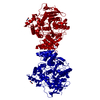 7b2wC 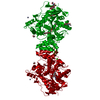 7b8eC 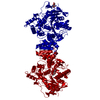 1ea5S S: Starting model for refinement C: citing same article ( |
|---|---|
| Similar structure data |
- Links
Links
- Assembly
Assembly
| Deposited unit | 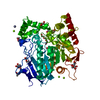
| ||||||||||||
|---|---|---|---|---|---|---|---|---|---|---|---|---|---|
| 1 | 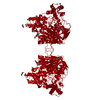
| ||||||||||||
| Unit cell |
|
- Components
Components
-Protein , 1 types, 1 molecules A
| #1: Protein | Mass: 60193.977 Da / Num. of mol.: 1 / Source method: isolated from a natural source Source: (natural)  Organ: ELECTRIC ORGAN / Variant: G2 FORM / Tissue: ELECTROPLAQUE / References: UniProt: P04058, acetylcholinesterase |
|---|
-Sugars , 2 types, 3 molecules 
| #2: Polysaccharide | alpha-L-fucopyranose-(1-6)-2-acetamido-2-deoxy-beta-D-glucopyranose Source method: isolated from a genetically manipulated source |
|---|---|
| #5: Sugar |
-Non-polymers , 7 types, 415 molecules 

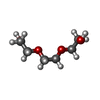


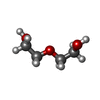







| #3: Chemical | ChemComp-MG / #4: Chemical | ChemComp-ZN / | #6: Chemical | ChemComp-PGE / | #7: Chemical | #8: Chemical | ChemComp-EDO / #9: Chemical | #10: Water | ChemComp-HOH / | |
|---|
-Details
| Has ligand of interest | Y |
|---|---|
| Has protein modification | Y |
-Experimental details
-Experiment
| Experiment | Method:  X-RAY DIFFRACTION / Number of used crystals: 1 X-RAY DIFFRACTION / Number of used crystals: 1 |
|---|
- Sample preparation
Sample preparation
| Crystal | Density Matthews: 3.24 Å3/Da / Density % sol: 62.04 % |
|---|---|
| Crystal grow | Temperature: 293 K / Method: vapor diffusion, hanging drop / pH: 5.8 Details: Mixing 2 uL of protein (10-13 mg/mL in 0.1 M NaCl/0.1 M 2-morpholinoethanesulfonic acid (MES)/0.02% sodium azide, pH 5.8) with 2 uL of precipitant solution (0.2 M magnesium acetate/10-15% ...Details: Mixing 2 uL of protein (10-13 mg/mL in 0.1 M NaCl/0.1 M 2-morpholinoethanesulfonic acid (MES)/0.02% sodium azide, pH 5.8) with 2 uL of precipitant solution (0.2 M magnesium acetate/10-15% (v/v) polyethylene glycol (PEG) 5000 monomethyl ether, 0.1 M MES, pH 6.5), thus yielding crystals of the Mg+2/TcAChE complex PH range: 5.8 |
-Data collection
| Diffraction | Mean temperature: 155 K / Serial crystal experiment: N |
|---|---|
| Diffraction source | Source:  SYNCHROTRON / Site: SYNCHROTRON / Site:  ESRF ESRF  / Beamline: ID14-2 / Wavelength: 0.93 Å / Beamline: ID14-2 / Wavelength: 0.93 Å |
| Detector | Type: ADSC QUANTUM 1 / Detector: CCD / Date: Jan 12, 2001 |
| Radiation | Protocol: SINGLE WAVELENGTH / Monochromatic (M) / Laue (L): M / Scattering type: x-ray |
| Radiation wavelength | Wavelength: 0.93 Å / Relative weight: 1 |
| Reflection | Resolution: 1.85→34.83 Å / Num. obs: 69953 / % possible obs: 99.7 % / Redundancy: 2 % / Biso Wilson estimate: 28.37 Å2 / CC1/2: 0.85 / Net I/σ(I): 10.6 |
| Reflection shell | Resolution: 1.86→1.87 Å / Mean I/σ(I) obs: 2.5 / Num. unique obs: 9954 / CC1/2: 0.3 / % possible all: 99.94 |
- Processing
Processing
| Software |
| |||||||||||||||||||||||||||||||||||||||||||||||||||||||||||||||||||||||||||||||||||||||||||||||||||||||||||||||||||||||||||||||||||||||||||||||||||||||||||||||||||||||||||||||
|---|---|---|---|---|---|---|---|---|---|---|---|---|---|---|---|---|---|---|---|---|---|---|---|---|---|---|---|---|---|---|---|---|---|---|---|---|---|---|---|---|---|---|---|---|---|---|---|---|---|---|---|---|---|---|---|---|---|---|---|---|---|---|---|---|---|---|---|---|---|---|---|---|---|---|---|---|---|---|---|---|---|---|---|---|---|---|---|---|---|---|---|---|---|---|---|---|---|---|---|---|---|---|---|---|---|---|---|---|---|---|---|---|---|---|---|---|---|---|---|---|---|---|---|---|---|---|---|---|---|---|---|---|---|---|---|---|---|---|---|---|---|---|---|---|---|---|---|---|---|---|---|---|---|---|---|---|---|---|---|---|---|---|---|---|---|---|---|---|---|---|---|---|---|---|---|---|
| Refinement | Method to determine structure:  MOLECULAR REPLACEMENT MOLECULAR REPLACEMENTStarting model: 1EA5 Resolution: 1.85→34.83 Å / SU ML: 0.213 / Cross valid method: FREE R-VALUE / Phase error: 26.1539 Stereochemistry target values: GeoStd + Monomer Library + CDL v1.2
| |||||||||||||||||||||||||||||||||||||||||||||||||||||||||||||||||||||||||||||||||||||||||||||||||||||||||||||||||||||||||||||||||||||||||||||||||||||||||||||||||||||||||||||||
| Solvent computation | Shrinkage radii: 0.9 Å / VDW probe radii: 1.11 Å / Solvent model: FLAT BULK SOLVENT MODEL | |||||||||||||||||||||||||||||||||||||||||||||||||||||||||||||||||||||||||||||||||||||||||||||||||||||||||||||||||||||||||||||||||||||||||||||||||||||||||||||||||||||||||||||||
| Displacement parameters | Biso mean: 36.12 Å2 | |||||||||||||||||||||||||||||||||||||||||||||||||||||||||||||||||||||||||||||||||||||||||||||||||||||||||||||||||||||||||||||||||||||||||||||||||||||||||||||||||||||||||||||||
| Refinement step | Cycle: LAST / Resolution: 1.85→34.83 Å
| |||||||||||||||||||||||||||||||||||||||||||||||||||||||||||||||||||||||||||||||||||||||||||||||||||||||||||||||||||||||||||||||||||||||||||||||||||||||||||||||||||||||||||||||
| Refine LS restraints |
| |||||||||||||||||||||||||||||||||||||||||||||||||||||||||||||||||||||||||||||||||||||||||||||||||||||||||||||||||||||||||||||||||||||||||||||||||||||||||||||||||||||||||||||||
| LS refinement shell |
|
 Movie
Movie Controller
Controller



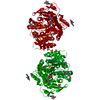

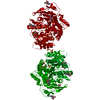
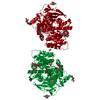
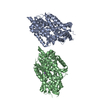

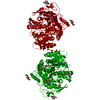
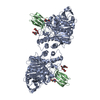
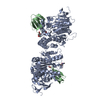

 PDBj
PDBj







